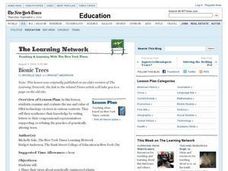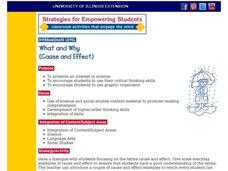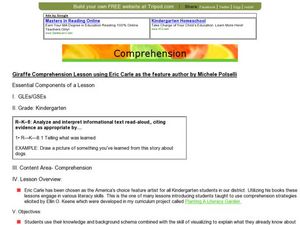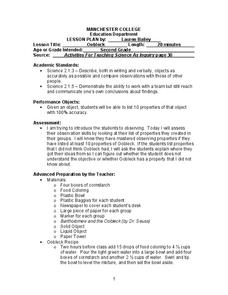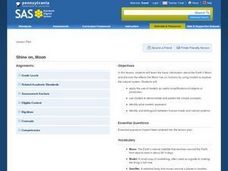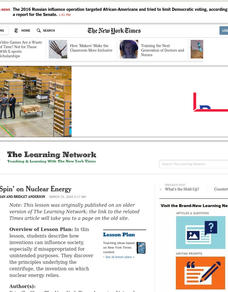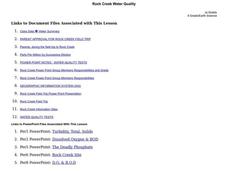Curated OER
Sticky Spiders
Students learn about spider webs. In this spider web lesson, students listen to and read the transcript of a discussion with science reporter, Bob Hirshon about spider webs. They answer comprehension questions based on the transcript.
Curated OER
Basic Knowledge of Big Cats
First graders create a KWL chart on big cats. For this animal science lesson, 1st graders brainstorm what they already know about big cats and research big cats using various suggested websites. Students fill in the last column of the...
Curated OER
Bat Quest: In Search of Stellaluna
Students participate in Bat Quest: In Search of Stellaluna. In this children's literature activity students listen to the reading of Stellaluna. Computers are utilized to enter the Bat Quest site to research various topics on bats....
Curated OER
Sharing the Joy of a Garden
Students see that a garden is a place where an individual can go for inner peace and solitude. They discover that a garden is to be shared. Students describe the importance that a garden has to the environment and lives of individuals...
Curated OER
The Final Word
Students research biographies of Americans who advanced science. They create an obituary for the person to share what information they have gathered. They discuss the importance of the obituary as the "final word" of a person to complete...
Curated OER
Rock Creek Water Quality
Ninth graders test water in a local creek using chemical kits and probes. They take GPS readings and digital photos. They calculate the Water Quality Index and create a spreadsheet of the test data.
Curated OER
Vertebrates are Cool!
Students conduct research on various vertebrates. They read the eBook 'Vertebrates,' select a vertebrate, conduct research, and create an eBook with one photo about their chosen vertebrate.
Curated OER
Bionic Trees
Students examine the debate about using trees to clean up the environment by reading and discussing a news article. They research the various contexts for which scientists may want to genetically alter trees and assess the validity of...
Curated OER
Scientific Scenes
Students discover how the public's perceptions of science have changed throughout recent history; then research scientific and technological breakthroughs in a variety of areas. They then create plays that allow scientists to encounter...
Curated OER
What and Why (Cause and Effect)
Students examine cause and effect. For this cause and effect lesson, students discuss examples of cause and effect that their instructor shares with them. Students identify examples of cause and effect in their own lives and then...
Curated OER
I Can See You
Second graders explore living without sight. In this senses lesson, 2nd graders review the different senses and what they use for each sense. Students discuss what it would be like to not be able to see and they read a story about a...
Curated OER
Digital Picture Water Source Hunt
Students use a technological format to illustrate their understanding of the importance of water to life. For this water lesson, students read a picture a book and discuss the need for water. Students create a class chart about uses...
Curated OER
Introduction to Topographic Maps
Tenth graders create a topographic map and see how it represents different elevations. In this topographic maps lesson students read and interpret topographic maps.
Curated OER
Simulation Test
Students evaluate an ecosystem and consider how it would respond to varied events. In this Earth science lesson, students work in small groups to analyze an ecosystem's response to teacher created scenarios. Student's compare their...
Curated OER
Using Newsprint as a UV Detector
Students investigate the effects of UV radiation. In this earth science lesson, students explain how the time of day relate to UV abundance on Earth. They determine if weather affects the amount of UV that Earth receives.
Curated OER
How Do They Know That
Students explore methods for reconstructing the past. In this forest succession lesson, students examine forest succession and how to read the land in order to predict patterns of change. Students will visit a historical site, act as an...
Curated OER
Children Just Like Me: Celebrations!
Learners read literature that is multicultural in order to investigate the types of celebrations that people have in relation to holidays around the world. They can link up with different celebrations looking for similarities to how the...
Curated OER
I Want to Believe: Astrologers and Sceptics in King Lear
Students examine two conflicting writings on solar eclipse that occurred on Black Monday and discuss them in the context of Shakespeare's King Lear. In this Shakespeare lesson, students discuss astrology and read the speeches made in Act...
Curated OER
Because of Winn Dixie: Water Management Practices
Fourth graders read the book Because of Winn Dixie and define the characters, setting, and plot. In this Winn Dixie lesson plan, 4th graders also identify quality water management techniques addressed in the story.
Curated OER
Giraffe Comprehension using Eric Carle as the Feature Author
Students demonstrate reading comprehension by drawing a picture and writing a sentence about giraffes. In this early reading comprehension lesson, students listen to a read aloud and watch a video about giraffes before drawing a giraffe...
Curated OER
Oobleck
Second graders observe the properties of Oobleck. In this science and observation lesson, 2nd graders examine Oobleck and make a list of 10 properties that they notice. They explain their observations.
Curated OER
Shine On, Moon
Students explore space science by conducting an experiment in class. In this Moon instructional activity, students define a list of space science vocabulary and read the book The Moon. Students utilize shoeboxes and string to conduct a...
Curated OER
A New "Spin" on Nuclear Energy
Students explain how the spin cycle of a washing machine operates. They explore other applications of the centrifuge by reading and discussing the article "Slender and Elegant, It Fuels the Bomb."
Curated OER
Rock Creek Water Quality
Ninth graders test water in a local creek using chemical kits and probes. They take GPS readings and digital photographs. They calculate the Water Quality Index and create a spreadsheet.







